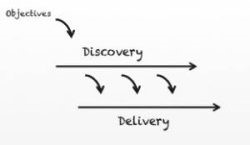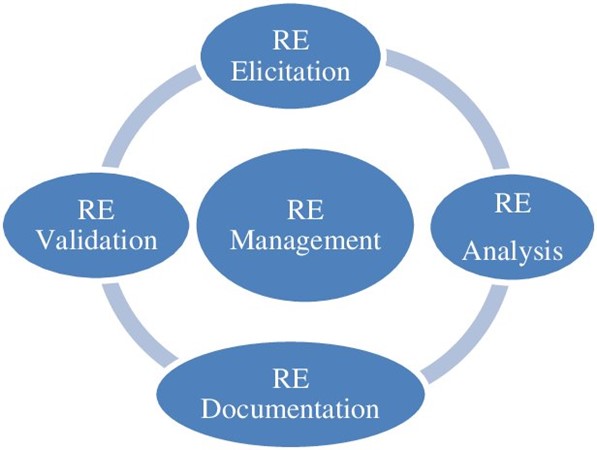
How Product Discovery Deals with Requirements
If you are working in products, you certainly have realized product management handle requirements differently. There is a shift from eliciting stakeholders’ wishes to discovering better and faster ways to solve stakeholders’ problems. This article presents how discovery techniques popular within product management fit in the three types of requirements: business, stakeholder and solution. Understanding where the techniques fit in this spectrum will allow a better understanding of how and when to use them.
Keywords: Requirements; Elicitation; Product discovery
What is Product Discovery and this “Modern” Elicitation
There may have been times in the past where business analysis was (incorrectly) seen as a passive discipline. Some might have viewed that a business analyst’s job when “gathering” requirements, most of the time, was attending meetings where they interviewed a group of people. Typically, these people had significant roles in the product (although most of the time they wouldn’t be the future users of the solution) and the business analyst would simply be a clerk and register all their dictated “wish list” items.
This approach is based on the premise that your sources know what they need and dictate the solution, yet how often is this actually realistic? More often there will be experimentation, change and the need for flexibility. The emergence of agile development methods and frameworks like Dual Track Agile, influenced organisations to split their efforts into product discovery and delivery.

The main shift on the premise of product delivery, compared to bespoke or market-driven requirements engineering, is that teams have to discover what the user’s problems are based on a set of assumptions and validate if a delivered solution contributes to the desired outcome. For business analysts, this means being involved in both the discovery and delivery processes, and it requires a shift in how requirements are elicited and managed. BAs need to challenge stakeholders’ perceptions on any assumed solutions and get to the underlying need using modern requirements techniques. They have to discover the requirements rather than gather them.
The Requirements Engineering Cycle
The cycle that typically involves elicitation, documentation, validation, and management of requirements is often associated with the broader field of Requirements Engineering or Requirements Management within the context of software development or project management. This cycle is iterative and continuous throughout the project lifecycle. Here’s how it works:
- Elicitation: Requirements are gathered from stakeholders, users, and other relevant sources. This step involves understanding their needs and expectations for the software or project.
- Documentation: The collected requirements are documented in a clear and comprehensive manner. This documentation can take various forms, such as a Software Requirements Specification (SRS), user stories, use cases, or other requirement documents.
- Validation: The documented requirements are then validated to ensure that they accurately represent the stakeholders’ needs and are feasible to implement. This involves checking for consistency, completeness, and correctness of the requirements.
- Management: Throughout the project, requirements are actively managed. This includes change management to handle updates or modifications to requirements, traceability to link requirements to design and testing, and prioritization to determine which requirements are most important.
The requirements process doesn’t end after the initial elicitation, documentation, and validation. It’s a continuous and iterative cycle because requirements may change over time due to evolving project goals, stakeholder feedback, or other factors. Therefore, effective management of requirements is essential to ensure that the project remains aligned with its objectives and stakeholder expectations. It often involves feedback loops, revisions, and ongoing communication with stakeholders to refine and adjust requirements as needed throughout the project’s lifecycle.

1. Discovery Techniques for Elicitation
“How might We…” Technique
The “How Might We” technique is a crucial aspect of the design thinking process and is often used in design sprints to frame problem statements and generate creative solutions. The “How Might We” technique involves rephrasing challenges or problem areas into open-ended questions that invite elicitation through brainstorming and creativity. The challenge is to rephrase it as an open-ended question that begins with “How might we…?” The “How Might We” statements invites participants to generate creative ideas without feeling restricted by existing limitations. It shifts the focus from problems to possibilities, and it helps teams explore solutions from different angles, often leading to innovative and unexpected outcomes.
Jobs-To-Be-Done
“Jobs-To-Be-Done” (JTBD) encourages us to appreciate why a product or service was “hired”, not only in a functional dimension, but also in circumstances and emotional dimensions. The book “Jobs to be Done – Theory to Practice” by Anthony Ulwick describes a framework that you can use to define your jobs, from setting your different customers, the different kinds of jobs (core, related, emotional, consumption chain and purchase decision jobs), and setting the desired outcomes.
The behaviours of the customers that afterwards lead to definition of the “hired” job are identified by observation. Observation is a common elicitation technique. In this case, rather than observing (or shadowing) in order to replicate a given process, an observation within JTBD aims to relate a behaviour to customer’s outcomes.
Continuous Interviews
Teresa Torres described a set of “continuous discovery habits” to engage customers in a continuous cadence. The main shift in doing interviews is that questions don’t focus on what customers want. Rather, questions should focus on their past experiences to discover an opportunity.
As the name states, it uses interviews techniques. Once more, a very popular way to perform elicitation. As mentioned, the main shift is that questions that are asked focus on their past experiences to discover an opportunity.
The Mom Test
the Mom Test is another interesting approach for conducting stakeholder interviews. It has similarities with “Continuous Discovery Habits”, as the questions should focus on their past experiences to discover an opportunity. The premise of the Mom test is: your mom will always like your idea, but doing the right questions can make her tell what you really need to hear. Elicitation by performing these kinds of interviews allows us to depict the problem in question, rather than waiting for the interviewees to tell us the solution they want.
Advertisement
2. Discovery Techniques for Analysis
Value Proposition Canvas
The Value Proposition Canvas is a strategic tool used in business and product development to understand and communicate how a product or service creates value for customers. It’s typically used in conjunction with the Business Model Canvas to create a holistic view of a business. The canvas helps businesses design their offerings by gaining a deep understanding of customer needs and how their products or services fulfil those needs.
It demonstrates a clear understanding of customer pains, gains, and jobs to be done, and introduces alignment of the pain relievers, gain creators, and product(s) benefits.
User Journeys
User journeys, also known as customer journeys or user experience (UX) journeys, are a product discovery technique that originated from the field of User Experience Design (UXD) and User-Centered Design (UCD). User journeys provide a visual representation of the user’s interactions and experiences while using a product or service. They aim to capture the user’s perspective, emotions, actions, and touchpoints across different stages of their interaction with the product.
Opportunity Solution Trees
Opportunity solution trees are a visualisation of potential solutions to a customer problem. They involve breaking down the problem into smaller opportunities, generating multiple solutions for each opportunity, and then evaluating and selecting the most promising solution.
It is our analysis work in getting insights from conducting the Continuous Interviews, allowing us to identify opportunities for our product.
3. Discovery Techniques for Documentation
Epic Alignment
“Epic alignment” is from Nils Janse’s book with the same name, proposes a single source of truth about the requirements, in form of a “lightweight” documentation that is based around epics. The structure that is proposed for this documentation includes information that is incrementally added to what we know about a given epic throughout the product development stages (namely, Ideation, Discovery, Prioritization, Refinement, Development and Testing). The structure of these documents allow to follow the information about an epic, which user stories are included, and the details that are needed for their implementation.
4. Discovery Techniques for Validation
User story mapping
The last technique I want to discuss in the article is user story mapping. This is a technique where team members collaboratively discover how a set of user stories solve a customer problem. The method consists of sequencing the user’s activities, and allows further elicitation to take place so that detailed stories and tasks can be captured. This in turn ensures that the solution will support the user’s activities that were presented.
Classifying this technique in a single stage can be tricky. I rather believe it encompasses elicitation, analysis and validation of requirements.
It’s a technique where team members collaboratively discover how a set of user stories solve a customer problem. End users may be involved in the collaborative process as well, most probably giving inputs in the user journey and the sequence of activities – which makes it an elicitation technique. Sequencing activities may be an output of previously performed elicitation, resulting from analysis of that information. Lastly, acceptance criteria may be included in the details of the story mapping, which forces the team to start stepping up into the requirements validation. In the case of users not have been part of collaborative process, the model may be used to validate together with users that the user journey is indeed correct.